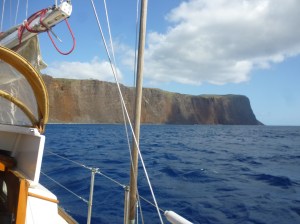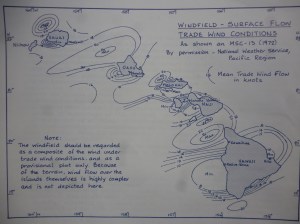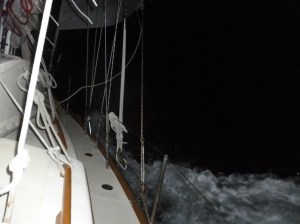Night Hopping to the Big Island
March 27
It wasn’t that the wind had come fair for a passage to the Big Island; this was simply the fairest it had been in days and days. Small craft advisories in all channels had been cancelled. Easterlies of 25 and 35 knots had given way to north easterlies of 20 with a promise to restrengthen by the weekend. I had plans to meet Joanna in Kona the first week of April–this could be my only shot.
During the day I secured the boat and then lay early in my bunk, wide-eyed and worried. The alarm wakes me at 0200. By 0300 I’ve made coffee, kitted up in boots and oilies, and we are underway, motoring below Diamond Head for the Kaiwi Channel to Lanai, Maui’s Fish Hook (the constellation Scorpius) our guide, bright and high. Wind in the channel comes on slowly but is 17 knots from the northeast by 0600, Murre close hauled at nearly five knots. By 0900 it is gusting 22 but the wind has veered more into the north as we come behind Molokai and so I can ease our single reefed main and jib. Still, the rail is under, water everywhere.
Around 0800 I see whale spouts and soon there are two dead ahead but five boat lengths off. Both disappear without sounding; Murre and I pass and we never see them again. Then at 0906, I am coming back on deck from breakfast and see a glossy black line in the water two boat lengths ahead. Before I can jump to the wheel a great fluke thrashes the ocean in front of the bowsprit and the whale dives, leaving a slick like that of a ships.
An hour later the wind abruptly eases to 6 knots from the east, and we are motoring with sails up. I’ve made it through, I think. But the lull is brief. Dark water ahead and the flash of white caps. When we are hit it is wind 20 gusting 25 from the east, forcing us to motor-sail as close hauled as can be for the last six hours to Kaumalapa Harbor on Lanai’s south side, tiny, rock-bound, with wind shooting down the canyon from the east and then the north. But secure, quiet, welcome. Anchor down by 1630. 57 miles in 13 and a half hours.
–
–
We had fixed some leaks, but the weather finds others. On this crossing, water came in the port Dorade vent. We were on port tack and heeled heavily. The vent only drains to port, so filled with spray and overflowed into the cabin.
Lentils for dinner and I am asleep an hour after sundown.
At 0200 the alarm sounds again, and again, by 0300 we are in the offing, making for the lee of Maui under a brilliant sky, the cliffs of Lanai dark and tall like the walls of an ancient fortress, wind soft on the face like breath. We motor around the island. The red lights of the turbines on Maui’s western mountains and the glow of the small town down and to the right. Phosphorescence bubbles by, tiny suns are born, go super nova, and return to the void.
At 0640 the sun tops Haleakala and within moments there is wind on the nose at 15 knots. I try wearing a diving mask to keep the continuous waves of spray from my eyes, but the sun strikes the water on the mask surface full-on and is blinding, reducing visibility to nothing.
By 0800 wind veers northeast and we sail for an hour; then it dies. I motor past Molokini, and, as it is early, I turn to take a spin through the moorings, already full with the day’s dive boats. Something strange about the water dead ahead. “Sailboat Sailboat go OUT and AROUND the reef!” calls the radio. Hard to port. I miss the reef, but have lost my taste for a spin through the mooring field.
1030. Anchor down at Makena in sand at 17 feet. Calm. I swim in the coral garden for an hour then fall asleep on the bow, waking to an uneasy motion. A chop is building suggesting wind from the northwest, and Murre is exposed. By noon the wind has picked up to 10 knots, but I can see much more headed our way. I weigh and we move around Pu’u Ola’i Hill to Olenoa (“Big Beach”) just as white caps pour into Makena. Wind tears through the rigging all afternoon, but Pu’u Ola’i knocks down the chop and Murre rides easy.
I have lentils for dinner again, but they are not tasty. I am not hungry. By sundown I am in my bunk–alarm set for midnight. The infamous Alenuihaha Channel is next, our last barrier to the Big Island’s lee.
These are all night crossings–The Kauai Channel, The Kaiwi Channel, The Alenuihaha–for a reason. Trade winds sweeping across the vast ocean meet the high islands of Hawaii and funnel around. Wind that is a mean velocity of 15 knots on the ocean can increase in the channels to 25 knots and more as it squeezes through. But it is not the wind we worry about, it’s the waves that, in such tight quarters, grow high and steep and out of proportion to their cousins on the open water. Similar issues face the cruiser in the Sea of Cortez as wind funnels down from Nevada and Arizona and sweeps the narrow water between the Baja peninsula and Mexico, creating what locals call “Buffaloes” for the way breakers charge along in a heavy rushing stampede.
In Hawaii the worst is the Alenuihaha because it is between Maui’s Haleakala at 10,000 feet and the Big Island’s much taller Mauna Kea. Wind velocities here are pushed beyond measure. Breaking seas of 12 and 15 feet are not uncommon. One deep-sea tug captain reports a big growler took out his wheelhouse. Again, I lay in my bunk not sleeping. I decide in my worry that Alenuihaha is Hawaiian for “the great alligator she is laughing.” Ale (gator) Nui (great) haha (obvious). Nevermind that alligators don’t grow here.

The Alenuihaha Channel from space. The camera is facing southwest with the Big Island on the left, Maui, Lanai, Molokai to the right. Note the flow of trade winds into the channel as indicated by the funneling of cumulus clouds. Maui's Haleakala at 10,000 feet can be seen as well as the Mauna Kea crater on the Big Island at 14,000. Upalo Point juts out into the channel and Murre's destination, Kailua-Kona is the dark spot of coast directly above Mauna Kea.
And the day heightens the effect. The sun heats the land pulling air up, making the wind funnel the channels with even greater speeds. So we wait for the blanketing of night, and we hope. I have to remind myself there are no small craft advisories forecasted. I have to remind myself we have worked UP to Maui for a reason and that an attack from here means we should take the Alenuihaha on a broad reach. Still, I have already double reefed the main.
I wake before midnight without the alarm. Both groggy and tense. Boots, long pants, double sweater (in the tropics? Yes!), oilies. Coffee. A snack bar in each pocket. A litre of water tucked under the rail. We are in the offing within the hour. Zero wind. The white water that blew out Makena anchorage in early afternoon is gone. But the channel is something different. There will be wind there. There is always wind in the channel.
By 0100 it has come. We are passing the point and wind is 20 gusting 22 northeast. And the waves? I can’t see them. The moon set an hour ago. Be we are close reaching. Course 160 degrees true. Perfect. Easy now, but we are not quite out from behind big Maui.
0200 and Murre is chopping along, keeping our course and racing at 6 to 6.5 knots. A little wet, but nothing to expectation. Heavy water over the top with a slam only twice. I make log entries from under the hood and note how luxurious it is to be dry and out of the wind. A grand night above: Mars is in Leo; Saturn in Virgo; Corvus points to the False Cross (I think). And Maui’s Fish Hook, our guide. So few constellations naturally look like the thing they represent. Orion, the Big Dipper, Maui’s Fish Hook–familiar friends.
Wind increases by 0300. I go back to the wheel to take in more of the jib, but I lose the sheets. By the time I’ve rolled up the entire sail, they have knotted together in what looks to be a decorative braid three feet long and so Gordian I think I may have to cut the line. It takes fifteen minutes for the knot to unravel.
Speed same. Course same. The chart plotter sounds an alarm and shows a small cruise ship on an intercept, the Safari Explorer doing 9.5 knots. She passes, a wink on the horizon. I sit under the hood and find I am worrying about tsunami debris approaching the Canadian coastline, ahead of my projected return course later this year. A fishing trawler washed into the Japan sea a year ago is now derelict and drifting 150 miles off Queen Charlotte Sound. Earlier predictions suggested debris would not arrive till late in the year. I would just skate through. But now? Not.
0500. Wind up and down between 20 and 25 but northeast. Blessed northeast–it is making this a comfortable run. Keeping our course takes fiddling. I opt for easing the main or drawing it in from under the hood for fine adjustments. Quite a roar in the rigging. Dawn coming. A haze over Mauna Kea, the island a slate slab. And with first light, the waves. Which are small now. We are behind Upolu Point twenty-five miles to windward. It must already be knocking them down.
0630. Sunup over the Big Island. Maui still visible astern. Wind 25. We are fast. Murre rides easy.
An hour later wind has dropped to 10 knots from the east, and an hour after that it has vanished into thin air. We are still twenty miles from port and must motor. Now the island is completely obscured by vog (volcanic smog/fog). Upolu Point is gone. Moana Kea at 14,000 feet is gone. No island is visible until we are eight miles out and still we motor in a dead calm. An anti climactic end to an otherwise lovely crossing.
We glass into Honokohau Harbor, just up from the town of Kilua-Kona, at 1430. 62 miles in 14 and a half hours.








Trackbacks
Comments are closed.